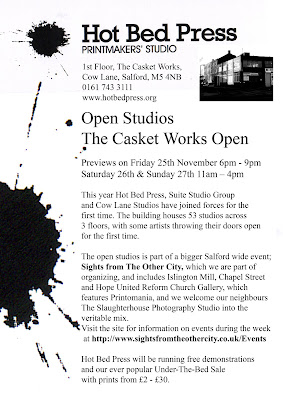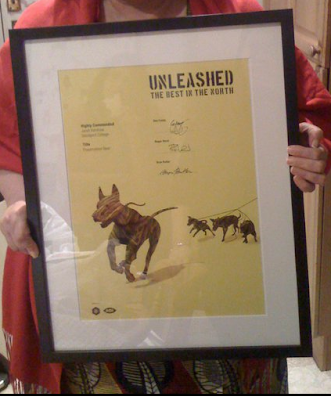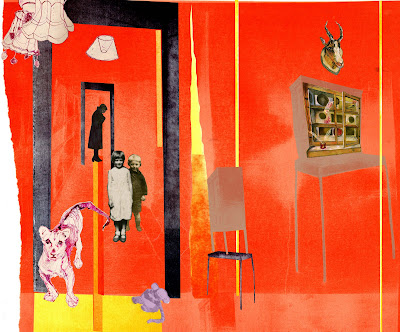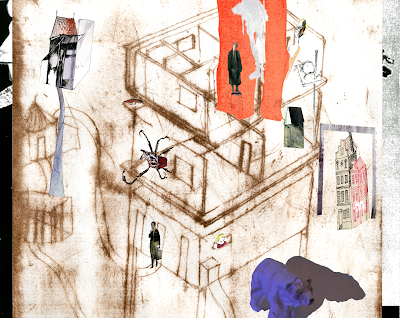
Friday 25 November 2011
Thursday 10 November 2011
Tuesday 8 November 2011
Tuesday 1 November 2011
Halloween at Platt Chapel
Wednesday 28 September 2011
Monday 25 July 2011
Thursday 21 July 2011
Saturday 16 July 2011
Unleashed auction night

It was a great night, so many talented illustrators. I am happy that some of my favourite works of art were selected, especially JoJo Norris's Troublesome Crowd, for which she won a bronze. It was a great honour to be shortlisted as the Best in the North, and I received a Highly Commended certificate. Lots of money was raised for both the artists and the charity North West Air Ambulance.
Thursday 7 July 2011
Piccadilly Station 30ft commercial showing Preservation Bear
Thursday 30 June 2011
Thursday 23 June 2011
Tuesday 14 June 2011
Degree Show
Monday 23 May 2011
Reply from Victo Ngai.


I received a prompt reply from Victo, whose work I love. and she was kind enough to give me some advice on my work, and enlighten me on her working process. I sent her the above image. Here is the transcript of her advice.
I really like the montage, the otherwordly colours and perspective contributed to a mysterious vibe. It's also smart of you to use large area of one dominating color, (the yellow) to tie all the different elements together. Your hand drawing has a lot of personality too.
The weakness of the piece for me is the composition and lack of focus. All the elements are in similar size and value structure, so there's not really a visual hierarchy - the eyes keep travelling from element to element but don't know where to look first or to stay. This may hinder getting across. Think of making illustration as directing a play - there are the main characters, side-kicks and props etc. If each person/thing is equally important, the audience may be confused.
Also, the circular composition makes the centre of the page look really import, yet there's nothing there ...
I hope this helps! Good luck with everything!
Best,
Victo.
The top image is one of Victo's, which can be seen on her blog, where she is generous to give her working process and also I like it that she includes the story and the process of thinking before she arrives at her final image. Its a good learning experience in that way. Victo's natural drawing and compositional and also interpretation skills are immense, I think, and I learn a lot from looking at her work.
Tuesday 17 May 2011
Professional Feedback regarding my work.
Reply from Gemma Daley, Head of Creative Services & Communications at Clinical Solutions and Freelance Designer.
Link to Gemma Daley's Website
My first impression is that the works are energetic and multi-faceted. They have a child like innocence and delicacy to the inked elements.
I appreciate and how the elements (color, shape, line, texture, space, form, value) are juxtaposed on the page to create an unnerved and enclosed feeling, the feeling of home but in the wrong place. The principles of design (balance, contrast, emphasis, movement/rhythm, unity, variety) have been used very well, particularly in the first two, the third (featuring the monkey) seems less evocative, perhaps as it features no humans?
I notice that the artist's choice of materials ranges from paint, ink, photography and paper textures, this gives the artwork energy and depth, enticing the viewer to engage and explore the work.
I think the artworks describe through the imagery and association, quite clearly what they are about. They are very accessible and I was able to understand the artists messaging. Overall I like the first and second piece as I feel the incorporate much more energy and feeling.
Reply from Elizabeth Eagle-Simbeye, Senior Digital Designer at Vividlime, and Director of 5Ten Design.
Link to 5Ten Design
Janet Kershaw’s colour palate is the first thing that strikes me considering the subject matter of her project. Its balance and control brings something new and sets the stage for each piece perfectly. The Zookeepers Wife is set in dark times, yet it is a story of hope, courage and kindness. It is empowering and I see this essence of empowerment and strength in the boldness of colour used.
From this initial boldness I was then drawn into the details of the artwork, the use of lines, shadow and depth helps to set each scene. My eyes naturally move around the pieces, taking in each element; some parts complex others simple illustrations and marking. The work is very much 3 dimensional and textured, which is in keeping with the story of ‘The Zoo Keepers Wife’.
The incorporation of collaged photography also works well, and again there is the natural balance that aids the composition. Object placement has been considered and layered to lead you further into the picture. There is a sense of darkness lurking the in the background, which you find yourself drawn to, yet that is where it stays – lurking. The joy and safety is within the confines of the zoo and Janet has captured this well.
Link to Gemma Daley's Website
My first impression is that the works are energetic and multi-faceted. They have a child like innocence and delicacy to the inked elements.
I appreciate and how the elements (color, shape, line, texture, space, form, value) are juxtaposed on the page to create an unnerved and enclosed feeling, the feeling of home but in the wrong place. The principles of design (balance, contrast, emphasis, movement/rhythm, unity, variety) have been used very well, particularly in the first two, the third (featuring the monkey) seems less evocative, perhaps as it features no humans?
I notice that the artist's choice of materials ranges from paint, ink, photography and paper textures, this gives the artwork energy and depth, enticing the viewer to engage and explore the work.
I think the artworks describe through the imagery and association, quite clearly what they are about. They are very accessible and I was able to understand the artists messaging. Overall I like the first and second piece as I feel the incorporate much more energy and feeling.
Reply from Elizabeth Eagle-Simbeye, Senior Digital Designer at Vividlime, and Director of 5Ten Design.
Link to 5Ten Design
Janet Kershaw’s colour palate is the first thing that strikes me considering the subject matter of her project. Its balance and control brings something new and sets the stage for each piece perfectly. The Zookeepers Wife is set in dark times, yet it is a story of hope, courage and kindness. It is empowering and I see this essence of empowerment and strength in the boldness of colour used.
From this initial boldness I was then drawn into the details of the artwork, the use of lines, shadow and depth helps to set each scene. My eyes naturally move around the pieces, taking in each element; some parts complex others simple illustrations and marking. The work is very much 3 dimensional and textured, which is in keeping with the story of ‘The Zoo Keepers Wife’.
The incorporation of collaged photography also works well, and again there is the natural balance that aids the composition. Object placement has been considered and layered to lead you further into the picture. There is a sense of darkness lurking the in the background, which you find yourself drawn to, yet that is where it stays – lurking. The joy and safety is within the confines of the zoo and Janet has captured this well.
Sunday 15 May 2011
Letter to Diane Ackerman, author of The Zookeeper's Wife.
Dear Diane,
I am an illustration student at Stockport College, Manchester, England, and I am in my third year and about to graduate soon. For my third year major project I chose to illustrate your wonderful book, "The Zookeeper's Wife" I have really enjoyed reading it, and you have really brought the situations to life through your wonderful interpretations of Antonina Zabinska's letters, and all your research.
I thought you might just like to see some of them, and I hope you don't mind my intrusion, I have attached some of them to this e-mail.
Thank you for your time,
Janet Kershaw.
I am an illustration student at Stockport College, Manchester, England, and I am in my third year and about to graduate soon. For my third year major project I chose to illustrate your wonderful book, "The Zookeeper's Wife" I have really enjoyed reading it, and you have really brought the situations to life through your wonderful interpretations of Antonina Zabinska's letters, and all your research.
I thought you might just like to see some of them, and I hope you don't mind my intrusion, I have attached some of them to this e-mail.
Thank you for your time,
Janet Kershaw.
Alain Verster.

I love the work of Alain Verster, who has recently graduated from the Royal Academy of Ghent. His sensitive use of printmaking and photographic imagery in this story De Duif de niet kon Duiken, translated as The Dove who could not dive, has sold immediately in Belgium, The Netherlands, Germany and France published by De Eenhoorn press.
My e-mails to different practitioners in the industry.
I have sent the following e-mail and attached PDF portfolio to Alain Verster, Victo Ngai and Kaatje Vermeire. I have also sent e-mails to two designer/illustrators, Gemma Daley, Head of Creative Services & Communications at Clinical Solutions, and Elizabeth Eagle-Simbeye, Senior Digital Designer, Vividlime, and 5Ten Design, asking for their feedback on my portfolio.
I am a student at Stockport College, studying for a degree in Illustration, and I am hopefully about to graduate soon. I would be very grateful for any feedback you might be able to give me on my attached pdf portfolio. Any comments or advice you have to give me on how I could improve my portfolio would be greatly appreciated.
Thank you for your time,
Janet Kershaw.
I am a student at Stockport College, studying for a degree in Illustration, and I am hopefully about to graduate soon. I would be very grateful for any feedback you might be able to give me on my attached pdf portfolio. Any comments or advice you have to give me on how I could improve my portfolio would be greatly appreciated.
Thank you for your time,
Janet Kershaw.
Evaluation of Major Project
I feel as though I have had a breakthrough in my work, as though I have caught a glimpse of something that I need to keep working towards. The new ability I have to combine my various techniques of working has enabled me to use my collaging skills to great advantage, seeing what might go together in an interesting way, and it is such a thrill to the eye. I could say that I wish I had managed it earlier in the course, but I have been working as hard as I can, and so I just think that it comes to each person when the time is right. I think I have learnt a lot on this course, and that it will become more obvious and relevant to me in the year to come. I am not looking for a particular style, and neither am I bothered about maintaining any style, but am open to change and where my interest takes me regarding technique. I think I probably have an innate style anyway, its just the way I do things.
I have really enjoyed working on The Zookeeper's Wife, its such a great story. It also allowed me to indulge my interests of animals and collecting and museums and entomology, modern architecture, polish illustration, etc etc; a bit of a gift really, illustration-wise. I do not feel as though I have finished, I want to carry on with it. I still have the show to work for. My initial proposal was to perhaps do a book, and to focus on the experience of the little boy, Rysz, who grew up at the Warsaw Zoo during the war years.
However, I found that I needed to look at the story as a whole, and that is what I have done, excerpting the view from the child's position might be another tangent. I think it is easier to tell a story, to create a narrative when you can combine different elements digitally, at least that is what I have been finding at the moment. I certainly have made a lot of imagery through various workshops and techniques that I can use for this. Putting together previously incompatible imagery, that would have been bound to the particular discipline they inhabit, is a new experience for me. Also working in layers means you are not bound to any particular sequence of working as one is in traditional media.
I am not saying here that I now wish to be a digital artist, far from it, I get wrist ache quite quickly, but it is nice to have the option and to be able to scrutinise other people's work and wonder how they achieved that handmade effect digitally.
I have done some interesting stories during this course, and I like the way some of the work I have done has come together on this project, as though there is something working and some synchronicity to it all.
I have really enjoyed working on The Zookeeper's Wife, its such a great story. It also allowed me to indulge my interests of animals and collecting and museums and entomology, modern architecture, polish illustration, etc etc; a bit of a gift really, illustration-wise. I do not feel as though I have finished, I want to carry on with it. I still have the show to work for. My initial proposal was to perhaps do a book, and to focus on the experience of the little boy, Rysz, who grew up at the Warsaw Zoo during the war years.
However, I found that I needed to look at the story as a whole, and that is what I have done, excerpting the view from the child's position might be another tangent. I think it is easier to tell a story, to create a narrative when you can combine different elements digitally, at least that is what I have been finding at the moment. I certainly have made a lot of imagery through various workshops and techniques that I can use for this. Putting together previously incompatible imagery, that would have been bound to the particular discipline they inhabit, is a new experience for me. Also working in layers means you are not bound to any particular sequence of working as one is in traditional media.
I am not saying here that I now wish to be a digital artist, far from it, I get wrist ache quite quickly, but it is nice to have the option and to be able to scrutinise other people's work and wonder how they achieved that handmade effect digitally.
I have done some interesting stories during this course, and I like the way some of the work I have done has come together on this project, as though there is something working and some synchronicity to it all.
House under a Crazy Star

Within the story I am illustrating, The Zookeeper's Wife, the house that sheltered the fugitives became known on the Polish Underground by the code name House under a Crazy Star. I love this image of the young boy's perspective on the house where he lived, and the magical feeling it seems to invoke. Also, the old photograph of the little girl in the sky area at the top suggests to me that it could either be a memory of his sister, as they had two children, or it could be a memory of a person who had passed through the house in hiding. The elevation of the house on stilts suggests a Noah's ark or a safe haven. The film A Safe Haven has been made of the story, and also a film is to be released as I understand, from Scion Films.
Hiding in the empty lion cages at the Warsaw Zoo


I wanted to show the contrast here of the bleakness it could have felt at times when sheltering in such a place, as mostly I have been dwelling on the anomaly and surrealist edge of humans hiding in animal cages. The musical evenings and meals held in the house by the Zabinski's and their "guests" are the subject of the top monoprint drawing which I am developing into an etching.
Hiding in the empty lion cages at the Warsaw Zoo

This is one of my final images for the mini exhibition. On the one side are the empty lion cages, and on the other side I have shown the more furnished side of the zoo "villa" as it was called in the book, and also the culture of collecting, specimen hunting and acquisition of knowledge that is characteristic of zoology, in the curiosity cabinet, or museum casing and stuffed animal trophy, that would have entailed hunting and trapping in exotic lands for the business that lay behind zookeeping.
The politics of Display in museum culture and zoology.



Nigel Rothfel's book Savages and Beasts traces the origins of the modern zoo in the efforts of nineteenth century German animal entrepreneur Carl Hagenbeck, shedding light on how seemingly enlightened ideas about the role of zoos and the nature of animal captivity developed out of the simple business of placing exotic creatures on public display. Within the book The Zookeeper's Wife, Diane Ackerman notes how Lutz Heck, a personal friend and also the director of the Berlin Zoo is interested in saving the Warsaw zoo because of his interest and the Nazi policies of eugenics and preservation of species such as the pryzwalski horses which the Warsaw zoo owned, and which survived the bombing, (of the type displayed in the Lascaux caves) and the aurochs or tur, and then extinct tarpan species which roamed in the Bialowieza forest in the strip of land between Poland and Russia, what would be modern day Belarus. Indeed, the mythology surrounding the forest, or the wild is not far removed in this story, in fact it is just behind a lot of the events. Simon Schama mentions in his book, Landscape and Memory, about the Bialowiecza forest and the mythology surrounding the the wild bison, known to the Poles as the tur and to the Germans as the aurochs. The Warsaw zoo was caught up in the politics of all of this public and private politics and passions.
Kumi Obata etchings
Szymon Tenenbaum's Entomology Collection.

This is one of my final pieces for the mini exhibition before the final show. I started to look at the architecture of the pinning of the insects whilst studying them at Manchester Museum. Having been looking at modern architecture a lot, I started to notice the resemblance of the constructed tiers and cantilevered systems. The display of tiny insects all pinned in hordes resembled a city in miniature, and I connected this with the street map I had seen of the Warsaw Ghetto, to which Szymon Tenenbaum, a professional entomologist, whilst the Nazi officer in charge had his collection put into safekeeping at the zoo. This event started the means of escape from the ghetto, and being able to enter and leave without too much suspicion, although it was fraught with danger. The resemblance of the street map, on the skirt of the woman, the platforms of the insects, the cast shadows and doorways, and the play of disguise are the basis for this image.
Images in progress.




Working with themes such as hiding and subterfuge, the pheasant house had a tunnel underground straight to the main house at the Warsaw Zoo, where the "guests" as they were called, could come out of hiding and have dinner, and frequently they had musical evenings, played the piano, and maybe they could dance a little. The piano featured in the subterfuge, as they had a coded of alert when a certain opera tune from Offenbach was played. The "exploded view" of a house is to show all the possible places of hiding, the sketch for a dinner evening, the pheasant house tunnel by night, and the general house furniture suggesting concealment behind normality.
Saturday 14 May 2011
Kaatje Vermeire again.

Kaatje Vermeire remains my number one favourite illustrator to aspire to. I suppose that would have to be my green with envy spot. Her interpretation is so sensitive and the imagery she uses for difficult to illustrate situations is just phenomenal, in my opinion. Her latest book, Mare en de Dinge, translated as Marie and the Things that Matter, from the Belgian publishers De Eenhoorn, is about the relationship of a child and her grandparents, and deals with happiness as well as death, loneliness and dementia in such a beautiful poignant way that I have to say, I am in awe of. She won this year's Bologna Ragazza, and is working on a book with Carll Cneut.
Subscribe to:
Posts (Atom)





















